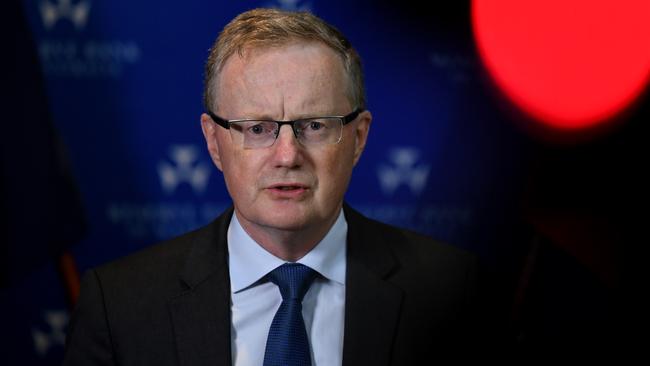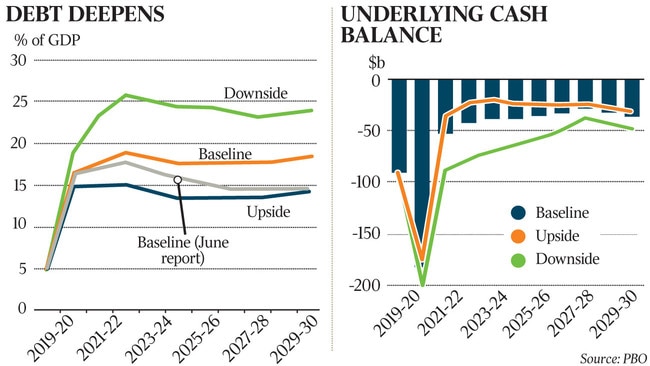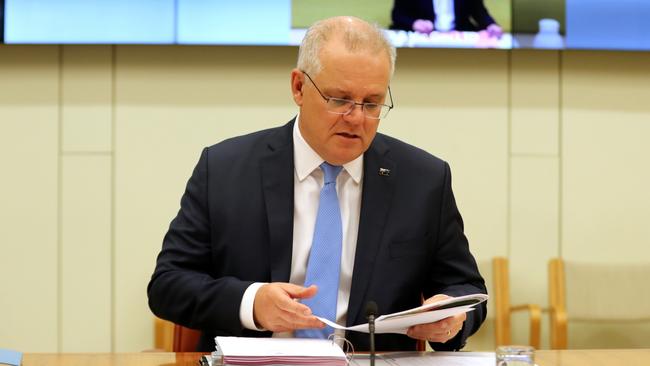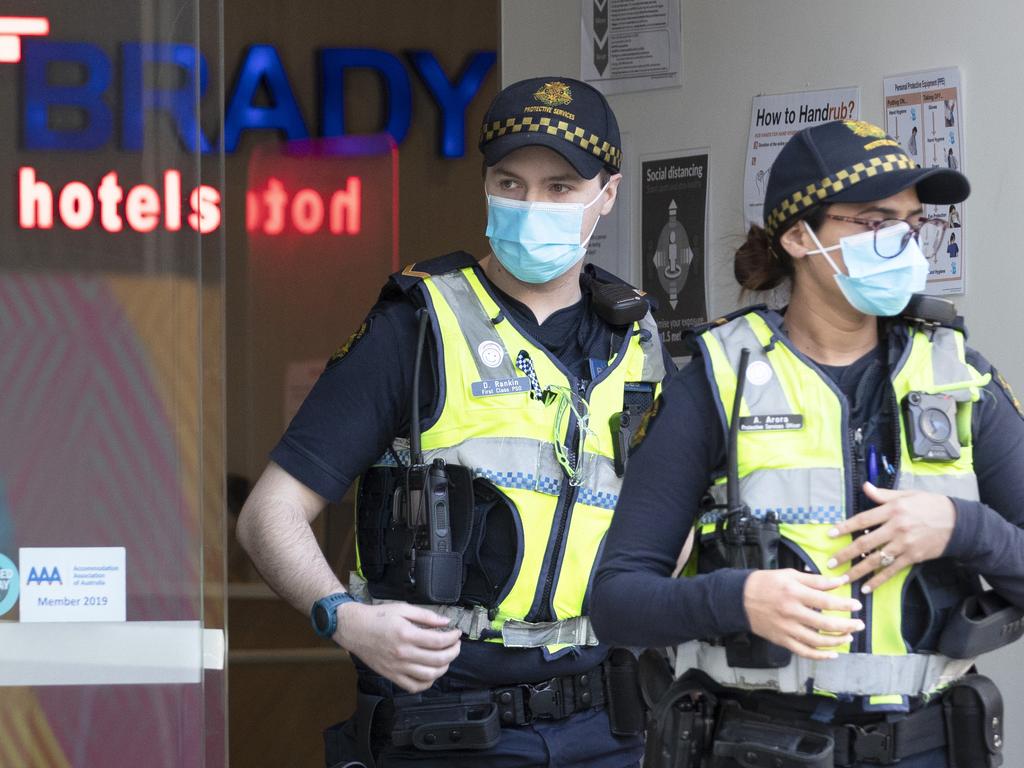Coronavirus: RBA governor Phillip Lowe calls on states to spend extra $40bn
Philip Lowe wants states to lift public spending over next two years to help create jobs and carry COVID burden.

The states and territories need to inject another $40bn into job-creating infrastructure after being told by Reserve Bank governor Philip Lowe they must muscle up to help the national economic recovery.
In a briefing to national cabinet on Friday, Dr Lowe told the states to effectively double their stimulus spending after last week accusing them of preserving their credit ratings at the expense of rolling out stimulus measures that would create jobs.

The premiers and chief ministers endorsed Dr Lowe’s calls to spend more on major infrastructure projects and job programs after a similar appeal from Scott Morrison two weeks ago, who said the federal government had done the heavy lifting.
Announcing the lifting of pandemic spending on the crisis-stricken aged-care sector to more than $1bn, the Prime Minister also brokered an agreement over the borders impasse between the states. The nation’s chief health advisers have been tasked with defining COVID-19 hotspots on medical grounds rather than arbitrary declarations by the states.
Broad agreement was also reached on rules and guidelines on medical access for communities hit by border lockouts. Queensland backed down on its earlier refusal to allow NSW patients on the border to be treated in Brisbane hospitals.
Guidelines around movement of agricultural workers and freight would also be established where border restrictions were in place.
Mr Morrison said that while the federal government’s economic and balance sheet measures to tackle the pandemic now totalled more than $314bn, this was a “week of hope” with Victoria beginning to “turn the corner” in its fight against the virus and progress being made on sourcing a vaccine.
Dr Lowe and Treasury secretary Steven Kennedy briefed state and territory leaders on the economic outlook, warning that unemployment was forecast to stay above 7 per cent for the next two years.
The economic briefing came as parliament’s independent budget watchdog issued a warning about the nation’s debt levels, revealing that Australia’s net debt burden was estimated to be up to $800bn higher than would have been the case without the COVID-19 crisis.
After the national cabinet meeting, Mr Morrison said the government’s key focus was on job creation, describing it as the “number one economic issue facing the nation”.
Three policy priority areas were identified by Dr Lowe: the provision of income support through programs such as JobKeeper and JobSeeker; the development of infrastructure and training programs across the areas of energy, transport, housing, schools and hospitals; and the implementation of measures to ease the cost of doing business.
“The level of commonwealth investment in fiscal intervention in this crisis is well over 15 per cent of our economy,” Mr Morrison said. “As a share of state product, the states in total (have committed) around 2.5 per cent.
“Now that ranges across the states and territories but the Reserve Bank governor called on the states and territories today to lift their fiscal investment over the next two years in programs of the nature that I’ve outlined … to the tune of 2 per cent of GDP or $40bn over the next two years.

“Right now, all of the announced measures of the states and territories are currently sitting in the vicinity of just shy of $48bn. So the governor is saying there needs to be an additional $40bn on top of that by the states and territories over the next two years.”
Dr Lowe told state and territory leaders they could absorb the debt required to fund the additional $40bn in spending. Mr Morrison said: “I would support that view. The expenditure, of course, needs to be purposeful. It needs to be targeted. It needs to go where it’s going to have the best effect.”
Ratings agencies backed the call from the central bank. Standard & Poor’s Global Ratings analyst Anthony Walker said: “State government balance sheets have plenty of room to accommodate additional infrastructure investment.”
Dr Lowe’s push for more public spending would force NSW to almost double the $55bn it had planned to spend on major projects over the next two years.
NSW Premier Gladys Berejiklian defended the sate government’s record on infrastructure.
“NSW is spending more than $55bn over the next two years, which is even more than Queensland, Tasmania, South Australia, Western Australia, NT and ACT’s infrastructure spend combined,” Ms Berejiklian said.
“Despite this, we are always looking to do more, especially in productive areas like transport, schools, and health that can significantly boost jobs.”
Victorian Treasurer Tim Pallas said his state was already undertaking a $107bn capital works program before the pandemic, and had since rolled out a $2.7bn stimulus package to bring forward hundreds of smaller infrastructure projects.
“Our massive pipeline of infrastructure projects has long been the bedrock of our economic strength and job creation,” Mr Pallas said. “It’s keeping our economy ticking through the pandemic and will be central to rebuilding on the other side. We’re carefully looking at what else we can bring forward to create jobs and repair the economy.”
Tasmanian Infrastructure Minister Michael Ferguson said the state was embarking on a $1.8bn infrastructure program over two years as part of a “comprehensive” COVID-19 recovery plan. “This will deliver an estimated $3.1bn in construction and support 15,000 jobs,” he said. “Tasmania is basically recognised for having done more heavy lifting than any other state as a share of our gross state product.”
The states were also told they would have to contribute to subsidies for airlines and aviation networks to keep operating within those states that had shut borders.
On Friday, the Parliamentary Budget Office forecast that Australia’s net debt burden would be $800bn higher than would have been the case without the COVID-19 crisis and that the budget would also remain tens of billions of dollars in the red.
The worst-case figure — based on the most pessimistic of the Reserve Bank’s downside, base-case and upside economic outlook scenarios — is $180bn worse than what the PBO estimated in June.
Similarly, the budget underlying cash position will deteriorate by between $31bn and $48bn in 2029–30 under the three RBA scenarios, the PBO said, compared with the December mid-year budget forecasts.
The PBO deficit estimates are significantly worse than the June forecasts, which had put the budget $16bn-$30bn worse off as a result of COVID-19.
Additional reporting: Joe Kelly, Kieran Gair, Rachel Baxendale, Matthew Denholm







To join the conversation, please log in. Don't have an account? Register
Join the conversation, you are commenting as Logout